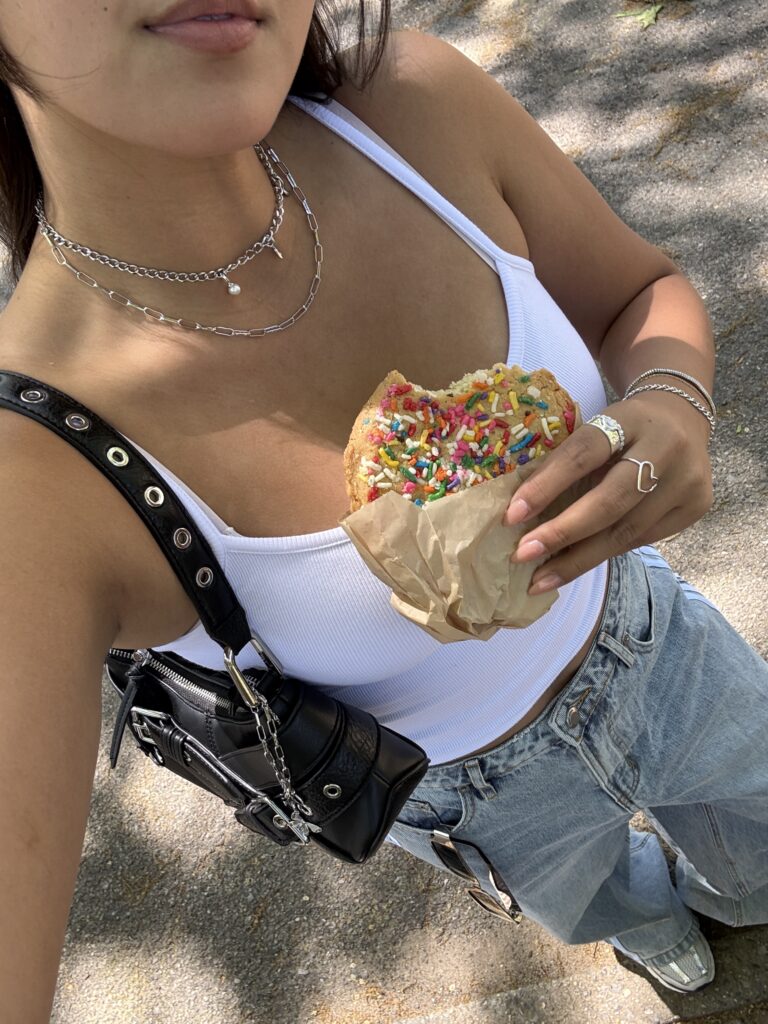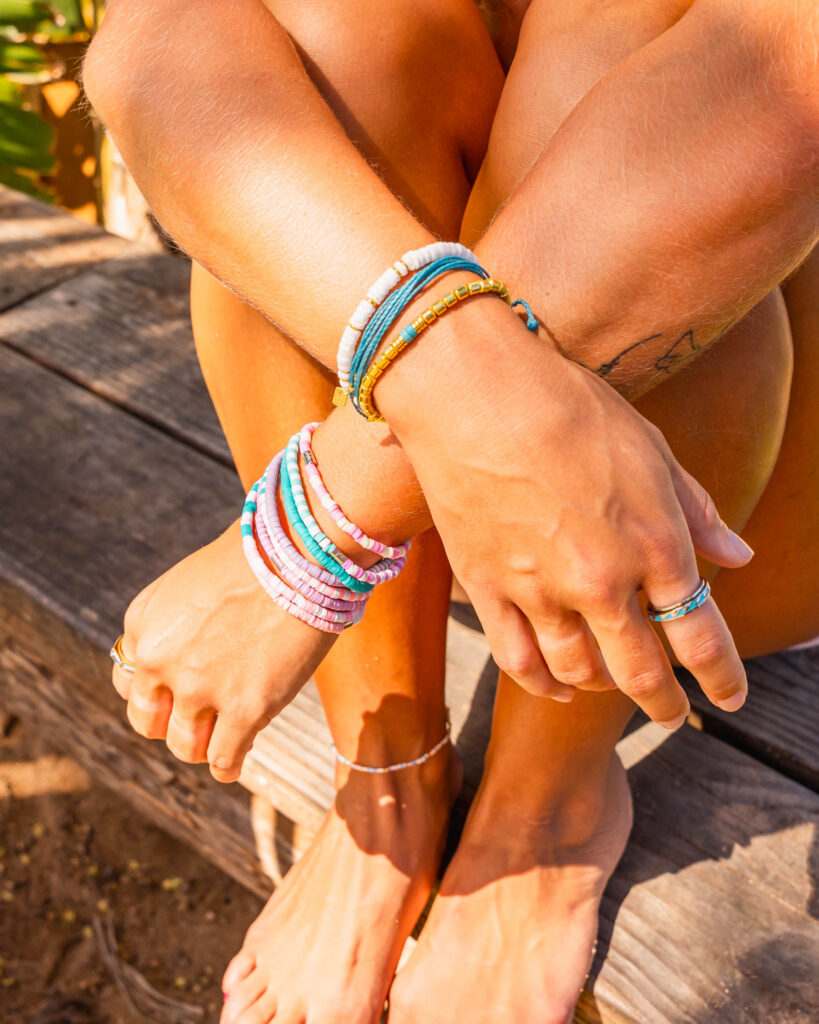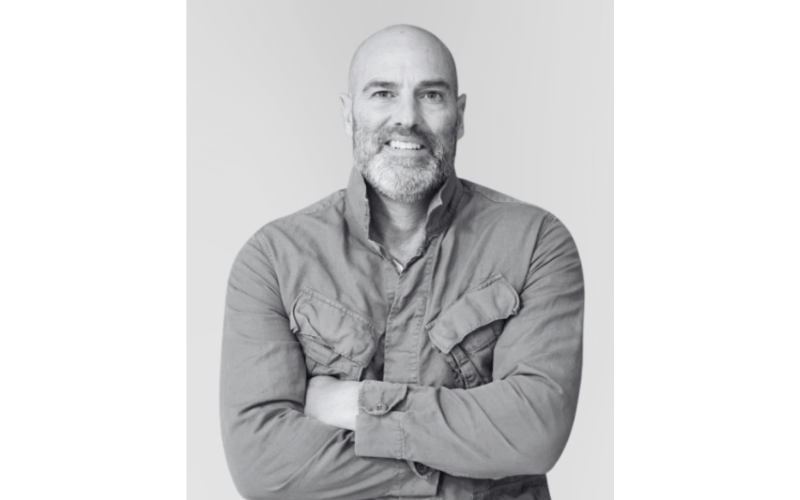Paul Frank co-founder and President Ryan Heuser joined Pura Vida Bracelets as CEO this summer and has big plans to turn around the brand.
The entrepreneurial Pura Vida grew rapidly under founders Griffin Thall and Paul Goodman, but struggled under publicly traded company Vera Bradley, which acquired the brand for a total of $85 million in two tranches starting in 2019. Pura Vida’s revenue dropped nearly in half during its tenure with Vera Bradley to $53.2 million in its most recent fiscal year. Vera Bradley sold the brand to CriticalPoint Capital earlier this year for $1 million, according to Vera Bradley financial documents filed with the SEC.
Heuser answered questions for us about his plans, which include refining the brand’s drop model, refreshing and eventually expanding Pura Vida’s retail stores and rebuilding trust and execution with wholesale partners.

Pura Vida has 2.1 million Instagram followers and nearly 1 million on TikTok. Photo courtesy of Pura Vida.
Who owns Pura Vida now?
Pura Vida CEO Ryan Heuser: Pura Vida is currently owned by CriticalPoint Capital, a private investment firm based in Los Angeles. After its initial stint as a founder-led brand, followed by public company ownership through Vera Bradley, this type of ownership structure is new for us at Pura Vida. It’s also relatively new territory for CriticalPoint, which has traditionally played in more B2B and industrial sectors rather than DTC. It’s exciting for both sides – we’re learning a ton and both sides of the team are bringing lots of energy to the table.
Why did you want to join the brand?
Ryan Heuser: In March of this year, I was brought in by CriticalPoint Capital (CPC) as a consultant. They had just acquired Pura Vida and asked me to evaluate the brand, identify growth opportunities, and offer creative direction. Just three days into the role, the sitting CEO announced he’d be stepping down by the end of the month.
Over lunch with him and a member of the CPC team, the idea was floated that I take the reins. At first, I dismissed it. But the more I thought about it, the more it made sense. I saw clear similarities between Pura Vida and Paul Frank: both are lifestyle-driven, creative, giftable, and community-centric.
I also saw it as an opportunity to do something I hadn’t done before – orchestrate a return to growth for a private equity-owned brand. That challenge really motivated me.
The other factor that played into my decision was the Pura Vida team. One of my favorite things in founding Paul Frank was working with an incredibly talented group of creative people, and I saw so many similarities between that Paul Frank team and the one at Pura Vida. It was just clear that they needed more support in moving the brand forward, and a chance to be unleashed in areas where they’d been held back. Across the board, I felt confident I knew exactly what Pura Vida needed and that I could deliver.
I now commute from Boise, Idaho, where I live with my wife and three kids. Their support was a big reason I accepted the role. It’s also an opportunity for me to expose my kids to an amazing career journey, one that I’ve been on for 30 years. I’m hopeful at least one of them follows in my footsteps.

Pura Vida, based in La Jolla, Calif., makes a wide range of jewelry. Photo courtesy of Pura Vida.
Pura Vida’s revenue has fallen the past few years pretty dramatically. How do you plan to turn things around?
Ryan Heuser: Let’s start with some perspective. Despite the decline, Pura Vida’s brand awareness and namesake still resonate deeply. We’ve built a powerful identity over the past 15 years and still dominate the handmade string bracelet space. Our social media presence is proof: 2.1 million Instagram followers and nearly 1 million on TikTok – we’re still connecting with Gen Z.
Internally, my first priority was culture. It had been a tough couple of years for the team, and we needed to get our fun and creativity back. One of my first moves? We answered fan mail that had been piling up. We wrote handwritten letters, sent stickers, bracelets, and heartfelt words to those that took the time and care to reach out to us. I wanted to reinforce our “Why.” The emotional connection to what we do and the impact the brand has is so important.
Some of the other big moves that we’re making have been brewing for some time and are in alignment with my early recommendations. The team just needed an advocate in getting them over the finish line. Operationally, we reduced our SKU count drastically. In prior years, the company had started to chase down every possible win and we ended up with way too much unsellable inventory. That won’t happen on my watch. Instead, we’ve launched an annual catalog of evergreen best-sellers and shifted to a highly focused seasonal, cut-to-order model.
It’s more profitable, reduces excess, and creates urgency. It also gives the brand a fresh look seasonally at retail.
We also just launched a new, gamified website tailored to our core audience, full of movement, fun, and color. We’re moving away from minimalism and into a more playful, expressive brand identity and tagline.
We’re also rolling out new branding. We will begin to roll out our new look later this year. To reinforce our branding, new website, and overall new identity, we’re refreshing all six company-owned stores, starting with UTC (San Diego) and Irvine Spectrum Center. Our refresh will be complete sometime in late September, early October. There’s a lot more in the works, but I don’t want to spoil all the surprises.
Marketing, especially social media advertising, used to be a big growth driver in Pura Vida’s heyday. How do you plan to market the brand going forward?
Ryan Heuser: I’m glad you asked. I’m a bit old school so buying hyper-targeted ads based solely on conversion metrics feels uninspired. Yes, we still do it, but staying relevant today requires more heart and creativity. One of my favorite ways of doing that is through branded collaborations. It’s a great way to test new categories, play with pricing thresholds, and create momentum.
Look for limited edition releases with unexpected partners through this year and into 2026.
We’re getting back to community-building: store-centric events and experiential activations combined with grassroots efforts. This is about building connections both digitally and physically. We’re still using social media for connection, but we’re also showing up and doing outreach.
Over the years, Pura Vida has donated more than $5 million, and that legacy of giving back remains core to our identity. However, we’re refining our approach to non-profit partnerships, narrowing them to better align with the ethos of the brand and the Gen Z customer. We’re also going to lean more single-mindedly into causes and partnerships that support women and girls, which are the majority of our customer base, as well as the majority of our employees.
Our first big move into this strategy is our new role as an official partner of the San Diego Wave Women’s Soccer team, a powerhouse team that’s right in our backyard.

Pura Vida plans to expand its retail fleet in 2026. Photo courtesy Pura Vida.
Any plans to grow Pura Vida’s retail fleet?
Ryan Heuser: Yes, but we’re starting by elevating what we already have. Our stores at UTC and Spectrum are being completely redesigned with help from some seasoned retail environment experts and our in-house art team. Much like our website redesign, our retail stores are going to look and feel completely different than they do today. The year 2026 will mark a truly new era for Pura Vida retail. I can’t disclose where we’re planning store openings, but we have established a methodical, long-term plan for how we choose locations and where we will open. We are creating a format we can replicate and roll out. Our strategy includes opening several new stores in 2026, adding onto our six existing locations. These stores will be pushing the boundaries on just how creative we can truly be.
At the same time, we’re improving everything behind the scenes. We are dialing in our product training, merchandising mix, store marketing, and how we are generating foot traffic and conversion. All these changes will set the foundation for our 2026 retail expansion.
What are you plans when it comes to wholesale distribution?
Ryan Heuser: It starts with being a good partner and I’ll be honest; we haven’t always been. That’s changing.
We’re working hard to rebuild trust and ensure the brand sells at wholesale. We’re also exploring new channels, including premium grocery. Pura Vida is a highly shareable brand, and we believe it can succeed in places outside traditional retail. We’re also mapping a go-to-market strategy across premium retailers, department stores, and specialty chains, and indie shops will remain our backbone.
It’s not just about where we’re placed, but how we show up. We’re improving our operational fundamentals: order accuracy, shipment times, onboarding, and customer service. Those factors shape brand perception at the buyer and store level and will ultimately lead us back to being the industry leader in our space.
How will you evolve the Pura Vida product line?
Ryan Heuser: I see a ton of opportunity for category expansion. The brand has been disciplined in terms of staying in our lane over the past decade, but now we have the chance to expand into other product categories where we know we have pent-up demand. I’m not able to disclose exactly what we’re currently working on, but we’ll expand into new product categories via license, collaborations, or by in-house design.
For example: we just revamped our print T-shirt program. This September, we’ll be introducing new bodies and an entire new look for soft goods that we know our customers will love.
The other area we’re working on is evolving into a more sophisticated omni-channel business, with distinct roles and goals for each channel. That means we’re exploring segmenting our product by channel to create cachet and demand across our retail, wholesale, and ecommerce businesses. We’re also rethinking pricing as a strategic lever for driving growth and demand, offering tiers of price points that better meet our customers where they are.






